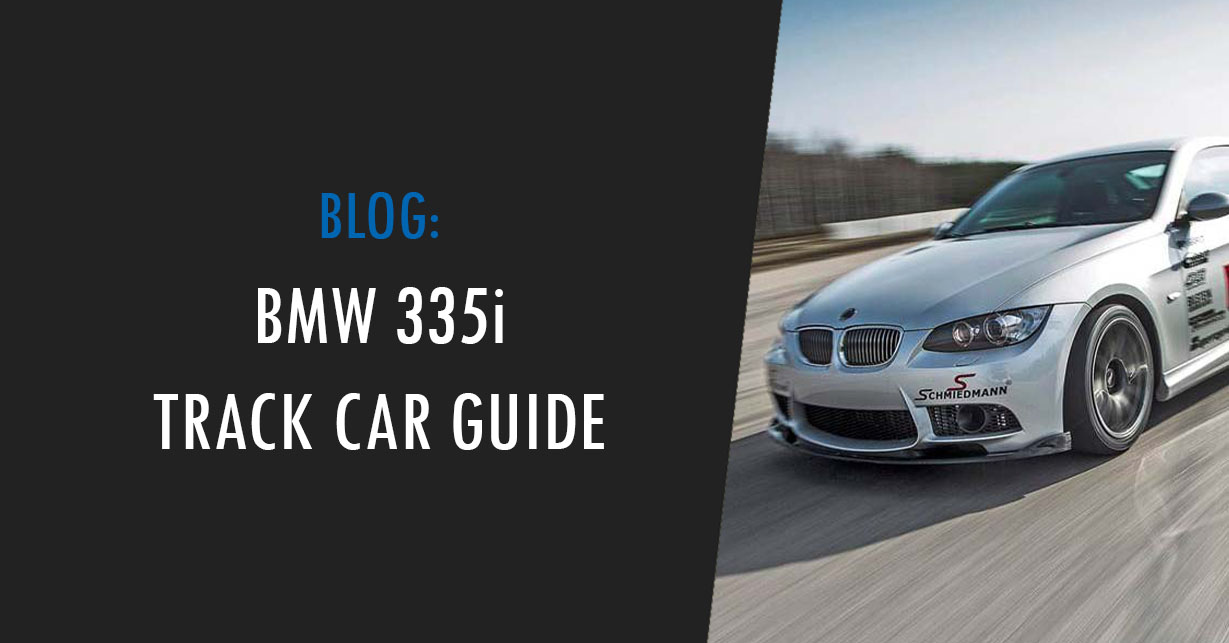The BMW 335i is a luxury sedan/coupe over a track car, but it is also a solid base upon which you can build a solid track car. What is needed to make the 335i a track car? Although any 335i is a very capable car in stock form, factory equipment may be insufficient for something more than a short lap or two. Upgrades will be needed if you want to beat smaller and lighter cars at the track.
In this comprehensive guide, we will delve into the mechanics of the BMW 335i and similar models, exploring the essential upgrades and modifications required to transform your 335i into an exceptional track machine.
Is the 335i a Good Track Car?
A 335i may not be as nimble as an E36, but its strong turbocharged inline-6 engine more than makes up for it on the straights. Yes, the 335i is a good track car when built with a balanced array of upgrades. No, a single turbo N54 335i with factory brakes and factory suspension does not count as balanced.
The 335i is primarily a luxury sedan/coupe designed to excel on the road as a comfortable but sporty daily driver. It is heavy compared to traditional track cars and it doesn’t come with a limited-slip differential from the factory.
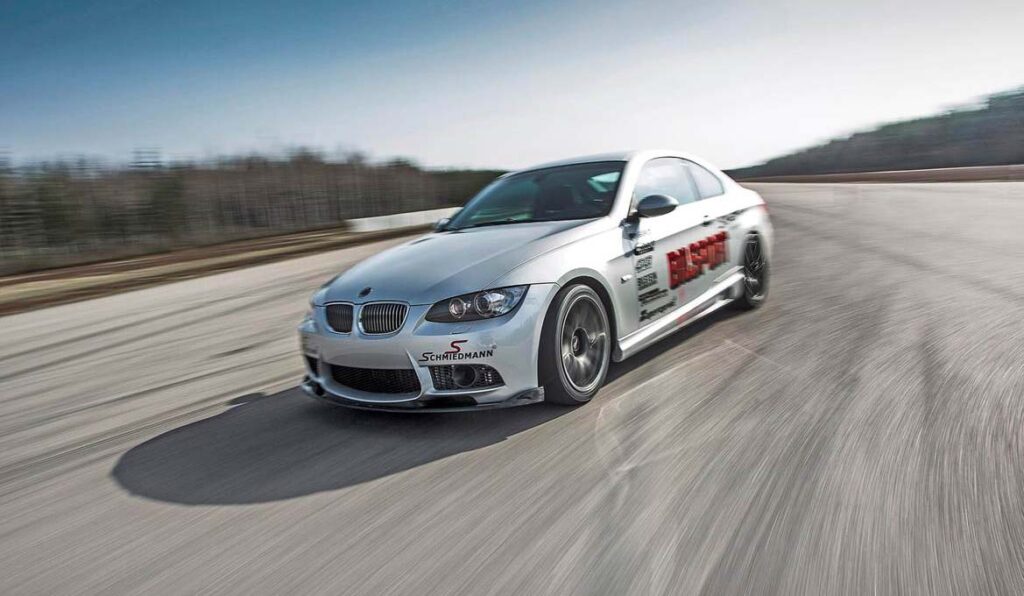
That said, the sporty factory tuning and suspension, strong engines, and excellent steering feedback make it a great starting point. As far as having an LSD is concerned, it is not true that you “need” an LSD to have a good track car as some of the most popular track cars out there don’t come with an LSD from the factory (Porsche Cayman, Lotus Elise).
Engine options: N54 or N55?
You can get a 335i with two different engines. All 2006-2010 E90/92 335i’s use the BMW N54B30 engine, while the 2011-2013 E90/E92 335i uses the N55B30M0 engine. The 335is (note the “s” at the end) uses the N54 exclusively, and the F30 335i uses only the N55. The N54 uses a twin-turbocharged setup, the N55 uses one large single-scroll turbo and it also gets Valvetronic and different fuel injectors, among other differences.
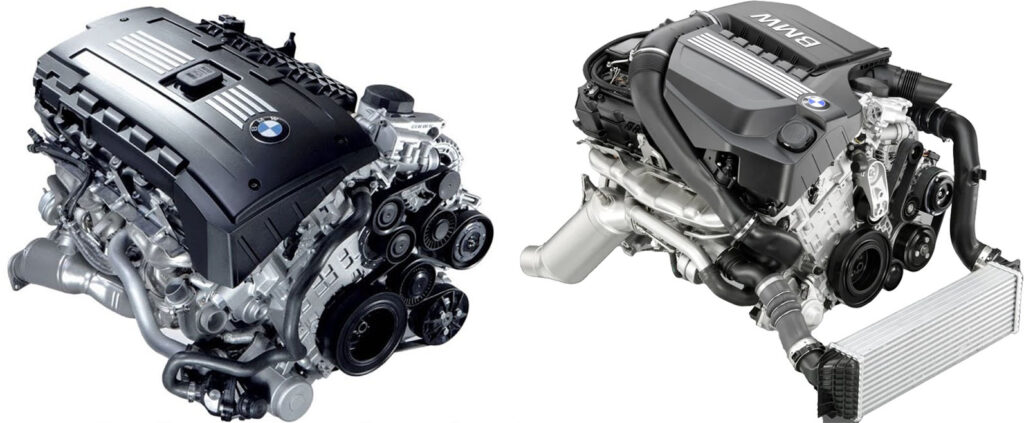
The N54 335i tops out at 302hp and 295lb-ft of torque and the N55 outputs the same power figures. The N55 has a slightly wider peak torque band, and the N54 has a higher lower-end torque. Other than that, power output is similar between both engines. For track use, the N54 is a better engine. It has a stronger engine block with higher tuning potential.
The N55 is a stout engine, but the internals are not as strong as the internals of the N54. Neither of these engines is closed-deck, but the N54 has a forged crankshaft and forged rods. The N55 on the other hand has a cast iron crankshaft and cast iron rods. The N54 can withstand higher power levels on the stock block.
Another reason why the N54 is an engine more apt for the track is that the N55 does not have the best oil sump configuration, which can fail to maintain a continuous stream of oil to the top of the engine when cornering hard at the track. Slightly overfilling the oil is a potential solution, but due to unknown tolerances, this is certainly a gamble.
You can’t go wrong with either one of these engines. The N54 has a higher tuning potential and the internals are stronger. The N55 is more reliable, and has a better sound. If you can keep up with the higher levels of maintenance needed, get an N54.
Transmission Options: Automatic or Manual?
The E90/E92 generation of the BMW 335i is available with two different transmission options. You can either go for a ZF 6-speed automatic transmission or a 6-speed manual transmission. The automatic transmission in the 335i is quite good for a 6-speed from the mid-2000s. It shifts faster and transfers engine power better than older automatics, such as the one in the E46. The 6-speed ZF transmission in the 335i can also withstand the increased torque of a tuned engine quite well.
For track use, we recommend either the 6-speed manual or an automatic transmission with a tune. A manual transmission will always offer you more control on the track. It allows you to control power delivery as delicately as you want.
A ZF-equipped might be half a second faster to 60mph, but 0-60 isn’t as important on the track. Moreover, the manual can withstand more abuse and is usually the cheaper unit to rebuild if necessary. A clutch upgrade might be needed on a highly-tuned vehicle.
Other transmission options for the 335i are the 7-speed DCT only available in the 335is and the 8-speed automatic of the F30 335i.
Engine Upgrades for a Track 335i:
1. Aluminum charge pipe
The stock plastic charge pipe on any N54 or N55 is known to crack and will cause a leak boost when it eventually does. Upgrading it right away to an aluminum unit is an excellent idea. These are undoubtedly the weak point of the N54/N55 and they can crack even while driving on the street at stock power levels.
An aluminum charge pipe not only increases reliability but also helps maximize airflow into the engine. This increases throttle response and also minimizes turbo lag.
2. Upgraded Intercooler
When tuning your 335i, a bigger intercooler is necessary. An upgraded intercooler cools charged air more efficiently. Colder air is denser, resulting in improved combustion and potential power gains.
A cold air intake works great with an upgraded intercooler as it can make the car breathe more freely while enhancing intake and turbo sounds.
3. Oil Cooler
For track use, it’s important to ensure your 335i is equipped with a factory-installed oil cooler. If your 335i is not equipped with one, try to source out the stock BMW oil cooler. Most 335is are already equipped with an oil cooler integrated into the oil filter housing, but not all of them have it.
An oil cooler is a must in the track as turbocharged engines produce a lot of heat that needs help dissipating. If you are looking for a secondary oil cooler apart from the factory-installed one, there are various aftermarket radiator-type oil coolers for N54 and N55 335i’s.
4. Catless Downpipe
For serious power gains, consider installing a catless downpipe accompanied by a tune. The catalytic converters in the stock downpipe restrict exhaust flow, and removing those will make exhaust flow more efficiently and in turn, help the turbo or turbos work better. The N54 has two separate downpipes while the N55 has just one.
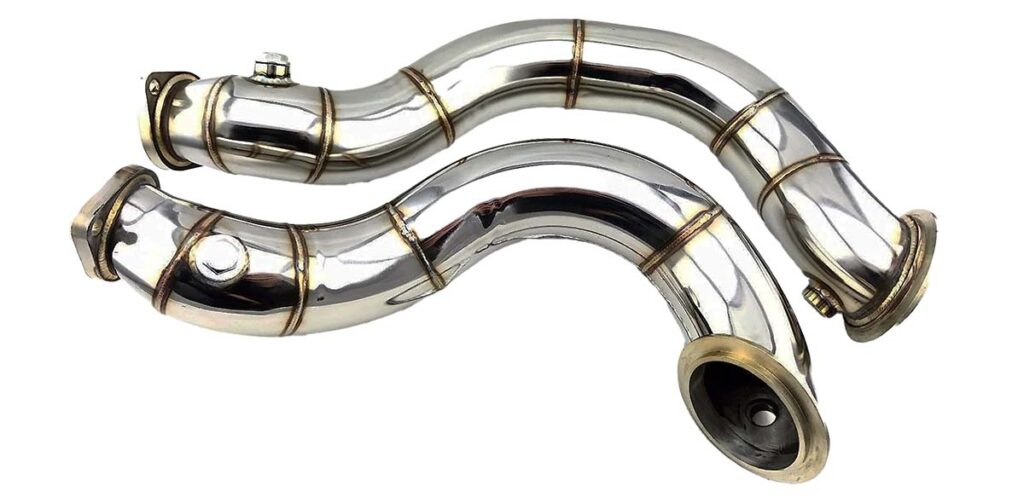
A catless downpipe will make your 335i louder and you’ll be able to hear the turbos sing more. Keep in mind that running a catless downpipe outside of the track can be illegal in some jurisdictions due to emissions regulations.
5. ECU tune
ECU tuning is a must once you have all the accompanying bolt-on upgrades such as upgraded charge pipe, intercooler, and catless downpipe. A tune will change the engine functions to be able to build more boost and have a stronger powerband.
There are different ways to tune your 335i. You can use some of the well-known off-the-shelf tunes like MHD or Bootmod3; these generally work very well and will rarely cause reliability issues. You can also bring your car to a tuning auto shop that specializes in European vehicles and they can tune it according to your needs and preferences.
We recommend using MHD or Bootmod3. These tunes have been widely tested and can bring a pretty noticeable jump in power.
Suspension, Tire, & Brake Upgrades for a Track 335i:
Although these upgrades are unlikely to make your 335i faster in a straight line, they’re just as important as engine upgrades. To optimize the handling and braking performance of your track-focused 335i, consider the following upgrades:
1. Performance tires
Michelin PS4s, Toyo R888, Hankook RS4, Continental Extreme Contact Sport. These are all some of the best options when it comes to performance track tires. Tires are the first points of contact between the track surface and your car. Good rubber means more grip, reduced body roll due to stiffer sidewalls, and more predictable handling.
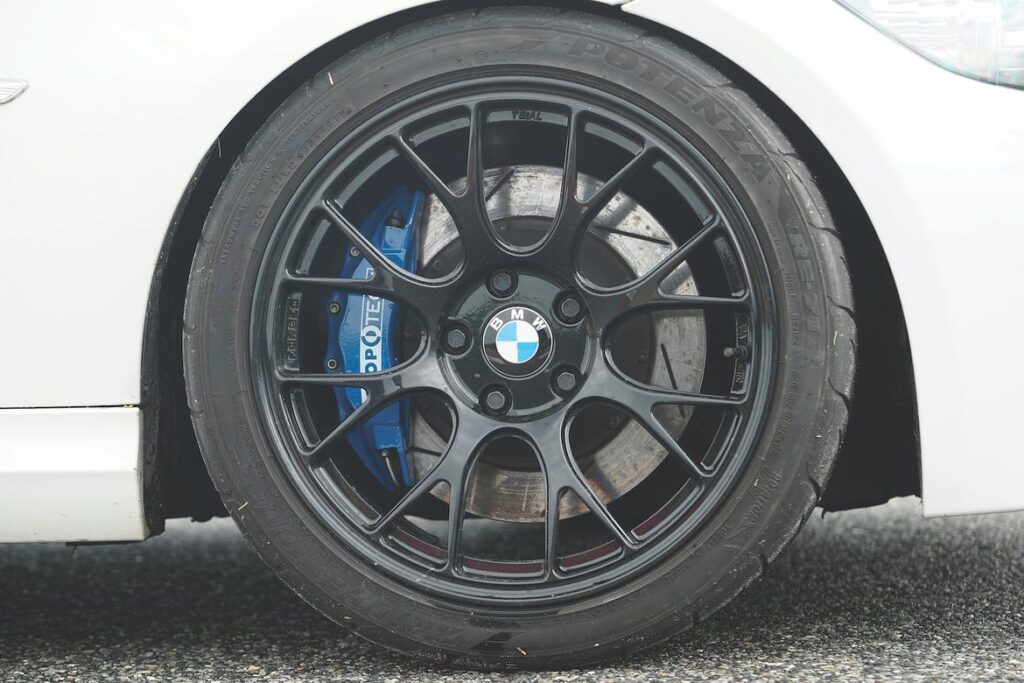
Note that a RWD 335i will let you run more flexible tire setups as the rolling circumference on all four tires doesn’t need to be the same.
On an RWD E90 335i, we recommend 235/40/18 front tires and 265/35/18 rear tires. For an xDrive AWD E90 335i, 245/35/18 tires on all four wheels are a great setup, but if you have rubbing issues on the front you’ll need to run 225s on the front and 255s on the rear.
2. High-performance Brake Fluid
Fresh high-performance DOT 4 brake fluid will allow you to brake harder lap after lap with reduced brake fade and a better brake pedal feel. Note that you should also replace brake fluid more frequently when tracking your 335i.
You should also consider upgrading your brake pads, rotors, and calipers if you plan to track your 335i for extended periods in tracks that are demanding on the brakes.
3. Big Brakes
The 335i factory brakes are nothing to scoff at. They’re already very strong for regular city driving and if your 335i is equipped with the M Performance Brake Kit, you should have no issues on the track.
If your 335i has the non-M Performance brakes, consider upgrading to either M3 brakes or M Performance brakes.
4. M3 Control Arms
In the rear-wheel-drive E90 335i, you can upgrade the control arms to those used in the BMW E90/E92 M3. This changes the driving dynamics of the car significantly as it modifies the camber to be more aggressive, making steering more precise and darty. The bushings are also stiffer, which transmits more road feel to the driver and reduces front-end vagueness.
5. Coilovers
A set of quality adjustable coilovers improves brings a significant improvement not only on the track but also on the street. Adjustable coilovers are preferred but Bilstein HD struts and shocks can also make a noticeable difference over your tired factory suspension.
6. Upgraded Sway Bar
An upgraded sway bar with stiffer bushings reduces play in the suspension while cornering hard. This means less body roll and more grip even in the sharpest turns.
You can also opt to keep your factory sway bar but simply upgrade the bushings or refresh them with original OEM sway bar bushings if you don’t want an increase in NVH.
Additional Mods & Upgrades:
In addition to engine, suspension, tire, and brake upgrades, there are several other modifications and upgrades that can further enhance the performance of your track-ready 335i:
Weight Reduction
If your power level is adequate and you want better acceleration and handling you can also reduce your overall weight for a better power-to-weight ratio. You can easily take out your trunk trim, your rear seats, remove sound deadening, and interior trim pieces, polycarbonate windows, and potentially even remove the front passenger seat.
Limited-slip Differential Upgrade
Consider upgrading to a limited-slip differential (LSD) to enhance power delivery to the wheels and improve the rear end’s predictability during cornering. An LSD helps distribute torque more effectively between the rear wheels, reducing wheel spin and providing better traction and stability. This upgrade significantly benefits acceleration out of corners, allowing for more precise power delivery.
E90 335i or F30 335i?
The BMW F30 335i uses the N55B30M0 engine; similar to the N55 in the 2011 and up E90 335i, but overall output is rated at 315hp and 332lb-ft which is a healthy upgrade over the N55/N54 E90. However, the E90 is much more confidence-inspiring, more predictable, and offers much more steering feedback, partially due to its superior hydraulic power steering setup.
While the F30 is also an excellent chassis with improved body rigidity and weight savings, the E90 is the perfect blend of old and new BMW while also being a very capable 3 Series.
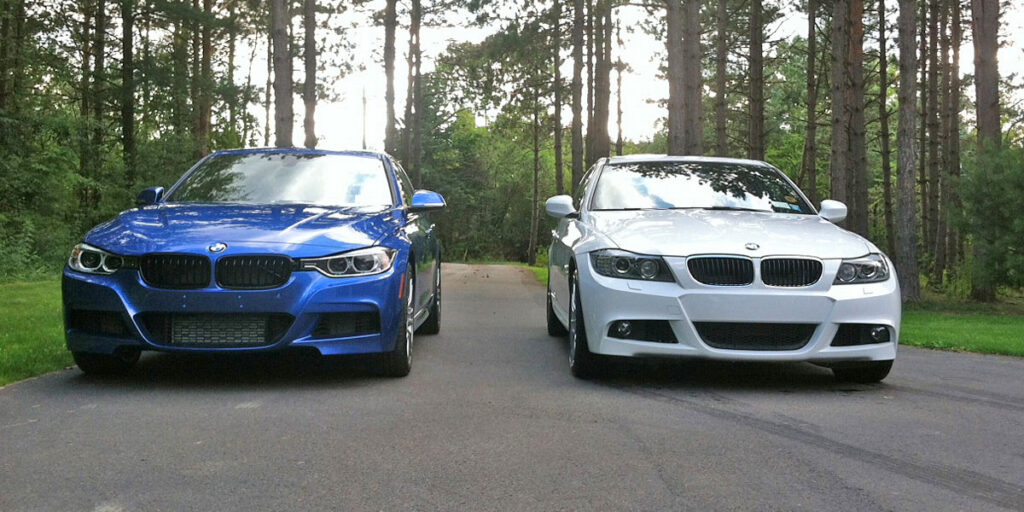
Both are available with manual transmissions, but finding a 6-speed F30 335i will be more difficult than finding a manual E90 335i. The 8-speed ZF 8HP automatic in the F30 335i is an excellent transmission, and much better than the 6-speed automatic of the E90.
We recommend the E90 335i over the F30 335i as it can be had with the N54 engine, has a better steering feel, and can be had for less than half of the price of a comparable F30, leaving you with more budget for upgrades.
RWD or xDrive (AWD) 335i?
For track use, we highly recommend a rear-wheel drive 335i. While an xDrive model will be faster from a dig and in wet conditions, the advantages of an RWD model will outweigh the advantages of an xDrive 335i.
Rear-wheel drive 335i advantages:
- Reduced weight (~200 lbs)
- Less understeer and better steering feel
- Fewer drivetrain losses
- Less maintenance
xDrive 335i advantages:
- Faster from a stop or low speeds
- Wet traction
Unless you plan on doing a lot of wet and rainy track days, a RWD 335i will be a much better option for the track.
Tuned 335i vs. M3 for the Track
A stock or even lightly tuned 335i can’t compete with the E90/E92 M3 on the track. The M3 has better suspension, better cooling, an LSD, big brakes, and the S65 is nothing to scoff at. The 335i indeed has more low-end torque with its turbo inline 6 but the high-revving V8 of the M3 can be better on most tracks.
A heavily tuned 335i can be a formidable beast and is likely to blow past the M3 on the straights, but the M3 will regain its lead in the corners due to better factory suspension, better factory brakes, a limited-slip differential, and a more rigid chassis.
Overall, the M3 is a better track car, but you can build three track 335i’s for the cost of one stock M3.
Additional Recommendations:
1. Avoid using a convertible 335i for the track
Don’t opt for the convertible version of the 335i. The E93 is heavier and its chassis lacks the structural rigidity of the coupe or the sedan, especially when the roof is down. Potential rollovers can easily be very dangerous as the roof is not as strong as the non-Cabrio versions.
It is highly recommended to opt for the coupe or sedan for your potential 335i track car.
2. Pay attention to the brakes
You do need to pay attention to potential brake fade, especially if you own a higher-mileage 335i. The factory brakes on the 335i are not designed for extended track sessions and can fade substantially if the track is demanding on brakes.
Final thoughts
The BMW 335i is a luxury sedan first and foremost, but it’s an excellent platform to base a track car due to its outstanding chassis and strong engine options.
We recommend doing maintenance before modifying or tuning your vehicle. Ensure the cooling system is fresh with no leaks to ensure optimum performance, and that your suspension and brakes are up to date.
A modified 335i can compete with an E90 M3 on the track. The N54 or the N55 have lots of low-end torque that can put the M3 to shame on a straight, but a 335i will need an upgraded suspension and excellent tires to keep up with an M3 on the bends. Unleash the full potential of your BMW 335i on the track with a balanced build.

